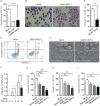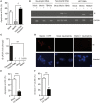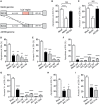Human Cytomegalovirus Delays Neutrophil Apoptosis and Stimulates the Release of a Prosurvival Secretome
- PMID: 28993776
- PMCID: PMC5622148
- DOI: 10.3389/fimmu.2017.01185
Human Cytomegalovirus Delays Neutrophil Apoptosis and Stimulates the Release of a Prosurvival Secretome
Abstract
Human cytomegalovirus (HCMV) is a major cause of viral disease in the young and the immune-suppressed. At sites of infection, HCMV recruits the neutrophil, a cell with a key role in orchestrating the initial immune response. Herein, we report a profound survival response in human neutrophils exposed to the clinical HCMV isolate Merlin, but not evident with the attenuated strain AD169, through suppression of apoptosis. The initial survival event, which is independent of viral gene expression and involves activation of the ERK/MAPK and NF-κB pathways, is augmented by HCMV-stimulated release of a secretory cytokine profile that further prolongs neutrophil lifespan. As aberrant neutrophil survival contributes to tissue damage, we predict that this may be relevant to the immune pathology of HCMV, and the presence of this effect in clinical HCMV strains and its absence in attenuated strains implies a beneficial effect to the virus in pathogenesis and/or dissemination. In addition, we show that HCMV-exposed neutrophils release factors that enhance monocyte recruitment and drive monocyte differentiation to a HCMV-permissive phenotype in an IL-6-dependent manner, thus providing an ideal vehicle for viral dissemination. This study increases understanding of HCMV-neutrophil interactions, highlighting the potential role of neutrophil recruitment as a virulence mechanism to promote HCMV pathology in the host and influence the dissemination of HCMV infection. Targeting these mechanisms may lead to new antiviral strategies aimed at limiting host damage and inhibiting viral spread.
Keywords: apoptosis; human cytomegalovirus; monocyte; neutrophil; polymorphonuclear leukocyte.
Figures








Similar articles
-
Decreased neutrophil adhesion to human cytomegalovirus-infected retinal pigment epithelial cells is mediated by virus-induced up-regulation of Fas ligand independent of neutrophil apoptosis.J Immunol. 2000 Oct 15;165(8):4405-13. doi: 10.4049/jimmunol.165.8.4405. J Immunol. 2000. PMID: 11035078
-
UL26 Attenuates IKKβ-Mediated Induction of Interferon-Stimulated Gene (ISG) Expression and Enhanced Protein ISGylation during Human Cytomegalovirus Infection.J Virol. 2019 Nov 13;93(23):e01052-19. doi: 10.1128/JVI.01052-19. Print 2019 Dec 1. J Virol. 2019. PMID: 31534044 Free PMC article.
-
Phenotypic alteration by dengue virus serotype 2 delays neutrophil apoptosis and stimulates the release of prosurvival secretome with immunomodulatory functions.J Leukoc Biol. 2024 Jan 19;115(2):276-292. doi: 10.1093/jleuko/qiad133. J Leukoc Biol. 2024. PMID: 37890093
-
Human cytomegalovirus induction of a unique signalsome during viral entry into monocytes mediates distinct functional changes: a strategy for viral dissemination.J Leukoc Biol. 2012 Oct;92(4):743-52. doi: 10.1189/jlb.0112040. Epub 2012 Jun 19. J Leukoc Biol. 2012. PMID: 22715139 Free PMC article. Review.
-
HCMV Infection and Apoptosis: How Do Monocytes Survive HCMV Infection?Viruses. 2018 Sep 29;10(10):533. doi: 10.3390/v10100533. Viruses. 2018. PMID: 30274264 Free PMC article. Review.
Cited by
-
Interactions of HIV and Antiretroviral Therapy With Neutrophils and Platelets.Front Immunol. 2021 Mar 12;12:634386. doi: 10.3389/fimmu.2021.634386. eCollection 2021. Front Immunol. 2021. PMID: 33777022 Free PMC article. Review.
-
Neutrophils in Inflammatory Diseases: Unraveling the Impact of Their Derived Molecules and Heterogeneity.Cells. 2023 Nov 13;12(22):2621. doi: 10.3390/cells12222621. Cells. 2023. PMID: 37998356 Free PMC article. Review.
-
Neutrophils at the crossroads of acute viral infections and severity.Mol Aspects Med. 2021 Oct;81:100996. doi: 10.1016/j.mam.2021.100996. Epub 2021 Jul 18. Mol Aspects Med. 2021. PMID: 34284874 Free PMC article. Review.
-
The human oral virome: Shedding light on the dark matter.Periodontol 2000. 2021 Oct;87(1):282-298. doi: 10.1111/prd.12396. Periodontol 2000. 2021. PMID: 34463988 Free PMC article. Review.
-
Predicting cytomegalovirus infection and graft-versus-host disease using QuantiFERON-CMV and Monitor in pediatric transplants: a proof-of-concept study.Ther Adv Hematol. 2025 Feb 8;16:20406207251316680. doi: 10.1177/20406207251316680. eCollection 2025. Ther Adv Hematol. 2025. PMID: 39926028 Free PMC article.
References
-
- Watson RW, Rotstein OD, Nathens AB, Parodo J, Marshall JC. Neutrophil apoptosis is modulated by endothelial transmigration and adhesion molecule engagement. J Immunol (1997) 158(2):945–53. - PubMed
Grants and funding
LinkOut - more resources
Full Text Sources
Other Literature Sources
Research Materials
Miscellaneous

